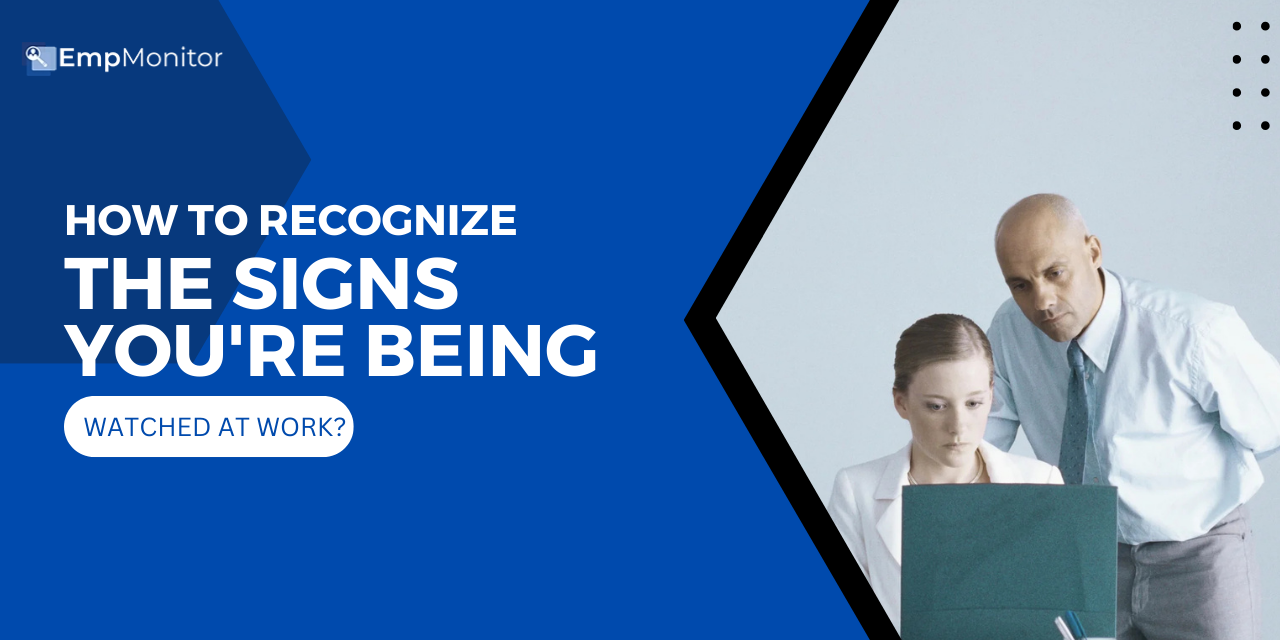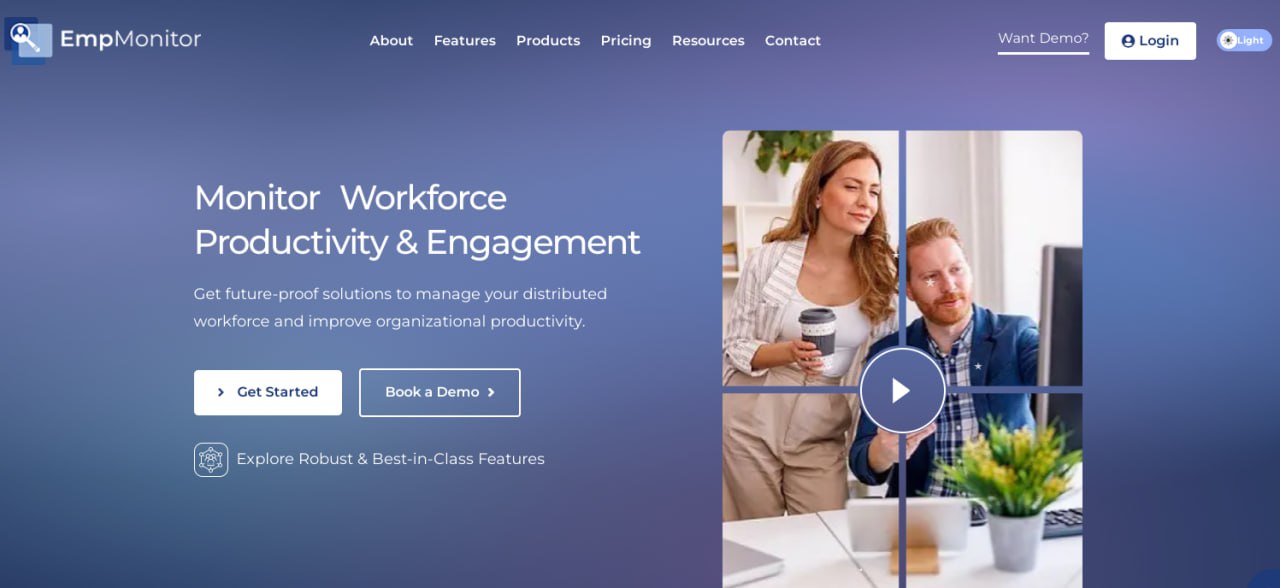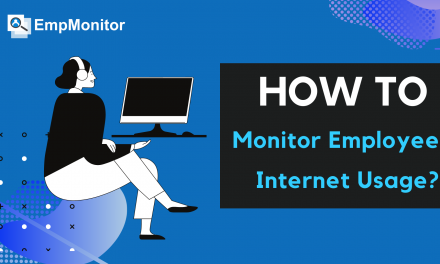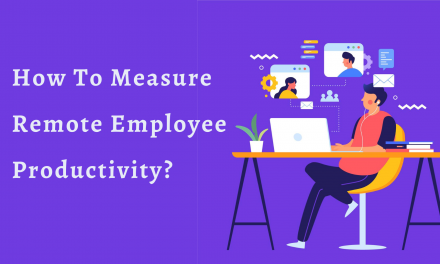Ever had that eerie feeling you’re being watched—even when you’re alone at your desk? That little gut nudge might not be paranoia after all. In today’s highly digitized workspaces, workplace monitoring software has become a silent, often invisible, colleague.
And while many assume such systems are used only in high-security environments, the truth is far more widespread. From keystroke loggers to webcam access, companies are increasingly turning to tracking software for laptops and other monitoring tools to ensure productivity, compliance, and security. But what happens when employees don’t even realize they’re under the microscope? These unnoticed digital footprints often turn into the earliest signs you’re being watched at work without even realizing it.
In this blog, we’ll uncover:
- The signs you’re being watched at work
- The types of monitoring systems in place
- Legal and ethical dimensions
- Steps you can take to safeguard your privacy
Let’s decode the digital surveillance around you.
Listen To The Podcast Now!
Why Monitoring Happens in the First Place
It all starts with one goal: control. Companies use surveillance to monitor performance, protect data, and ensure smooth operations. But how far is too far? Recognizing the signs you’re being watched at work can help employees stay aware of what’s being tracked and why.
Employers often cite operational efficiency as the primary reason for implementing monitoring systems. They argue it helps ensure tasks are being completed on time, resources are utilized properly, and any misuse of company property is flagged early on.
From their perspective, tools like employee tracking apps or employee productivity software are simply part of efficient management in a remote or hybrid environment. These tools can track:
- Login/logout times
- Time spent on certain apps or websites
- Emails and instant messages
- Project deadlines and completion rates
- Even physical movement, via GPS or badge swipes
However, many of these actions happen without explicit awareness from the employees, causing a disconnect and creating a potentially toxic environment rooted in mistrust. If you’re wondering how do I know if I am being monitored, there are several signs to look out for that can help you determine whether your activities are being tracked
Clue #1: Your Computer Is Acting… Weird
One of the earliest signs you’re being watched at work? Your computer starts acting strangely.
Sluggish performance, strange pop-ups, or even new background applications might mean workplace monitoring software has been silently installed.
Other subtle tech red flags:
- A constantly running webcam light
- Mouse or cursor movement without input
- Screenshots being taken without your knowledge
Some tracking software for laptops operates so covertly, you won’t even know it’s there—unless you look closely. Regularly check your task manager or activity monitor. If unknown programs are consuming high CPU usage, dig a little deeper.
Clue #2: Your Manager Knows… A Lot
 Have you ever had a conversation, searched for something, or typed a draft email—only to have your manager casually bring it up later?
Have you ever had a conversation, searched for something, or typed a draft email—only to have your manager casually bring it up later?
When superiors seem to have inside knowledge of your actions, that’s a strong clue—one of the most overlooked signs you’re being watched at work. Whether it’s how long you spent on a particular task or the specific tabs open during your break, they may be accessing nemployee activity monitorig software in real time.
While it’s entirely possible they’re just observant or hearing things from colleagues, repeated incidents like this often suggest these are signs you’re being watched at work
Clue #3: You’ve Been Asked to Install “Security” Tools
It starts innocently: “Please install this tool to help IT troubleshoot faster” or “This app will help track time better.”
But behind the scenes, these tools may have hidden capabilities like:
- Keylogging
- Screen capturing
- App usage tracking
If you notice signs you’re being watched at work, it’s crucial to be cautious. So before you click ‘Install,’ check the permissions. What’s it really accessing?
If it requests access to your microphone, webcam, or location and you’re not in a job role that requires those—it’s a red flag.
Clue #4: Security Policies Have Changed Drastically
Another subtle sign you are being monitored? Sudden policy shifts.
If your company updates its IT policy, internet usage terms, or requires you to sign a new “Acceptable Use” agreement, it’s likely they’re either implementing or expanding monitoring practices.
Here’s what to watch for:
- New password or multi-factor authentication protocols
- Restrictions on accessing certain websites
- Mandatory VPN usage at all times
- Prohibitions against using personal email or cloud storage at work
These steps often indicate increased oversight and are often tied directly to employee monitoring tools designed to lock down digital behavior.
The Ethics and Legality of Monitoring
Is all this even legal?
Surprisingly, yes—monitoring employees is legal in many parts of the world, especially if you’re using company-issued devices or working on the company network.
In the U.S., for instance:
- The Electronic Communications Privacy Act of 1986 allows employers to oversee electronic communications, provided they have a valid business reason for doing so.
- Employers aren’t always required to inform employees about monitoring unless state laws demand it.
To stay within legal bounds and respect privacy, companies must choose monitoring solutions that are transparent and comply with relevant regulations. Many organizations even share their monitoring policies through an interactive flipbook to make guidelines more engaging and easy to access.
EmpMonitor is one such ethical and legal solution. This employee monitoring software not only tracks productivity but also protects sensitive company data by identifying potential insider threats in real time.
Why EmpMonitor is the Ideal Employee Monitoring Software
When it comes to employee monitoring, EmpMonitor stands out as an ethical and legal solution that helps businesses track productivity, detect insider threats, and ensure data security.
Key Features of EmpMonitor:
-
Real-Time Insider Threat Detection
As a reliable insider threat detection software, EmpMonitor monitors user behavior in real time, flagging unusual activities like unauthorized file access to prevent data breaches.
-
Compliance with Legal Standards
EmpMonitor ensures employee monitoring practices comply with local and international privacy laws, providing detailed reports for transparency and legal protection.
-
Comprehensive Productivity Tracking
EmpMonitor tracks time spent on tasks, active hours, and app usage, helping businesses evaluate performance and identify areas for productivity improvement.
-
Data Privacy and Security
EmpMonitor ensures that employee interactions comply with security policies, safeguarding sensitive company data without compromising privacy. In situations where discretion is needed, EmpMonitor can operate in stealth mode to maintain confidentiality.
-
Detailed Reporting and Analytics
EmpMonitor generates insightful reports on employee activity, helping organizations make data-driven decisions and track trends over time.
EmpMonitor excels in crucial areas like real-time threat detection, compliance, and productivity tracking, making it a comprehensive solution for modern businesses.
Why Do Companies Monitor Employees?
In an age where remote and hybrid work is becoming the norm, companies are ramping up their use of workplace monitoring software to stay on top of productivity, security, and compliance. It’s not all about spying—it’s often framed as business necessity. But let’s break it down a bit:
Productivity and Performance Tracking
Employers want to see how time is spent. Are tasks being completed efficiently? Are employees focused? To answer these questions, businesses deploy tracking software for laptops that logs working hours, records active and idle time, and monitors which applications are in use. If you notice signs you’re being watched at work, it’s often tied to the implementation of these monitoring tools.
Security Measures
Cyber threats are real. To guard against data leaks or malicious activity, companies often track device usage, browser activity, file downloads, and USB connections. This form of tracking software for laptops acts as a virtual security guard, scanning for anything out of the ordinary.
Legal Compliance
Certain industries are required to maintain audit trails or verify that communications are compliant with legal standards. Monitoring helps in meeting these obligations and defending the company during disputes.
While the reasons may seem justified from an employer’s standpoint, the consequences for employee morale and trust can be significant.
Ways to Protect Yourself
While recognizing the signs you’re being watched at work is crucial, it’s equally important to know how to protect yourself. Here are some key ways to safeguard your privacy:
1. Understand Company Policies
The first step is to familiarize yourself with your company’s monitoring policies. Review your employee handbook or ask HR about the monitoring tools in use. Knowing what’s being tracked will help you set clear boundaries.
For companies or businesses that need to create professional and legally sound documentation, seeking professional paper help can be essential for developing clear, comprehensive monitoring policies and employee handbooks.
2. Use Personal Devices for Personal Activities
To maintain privacy, avoid using company devices for personal tasks. Use your own phone or laptop for personal browsing, emails, and social media to minimize the chances of your activities being monitored.
3. Be Cautious Online
Be mindful of what you share on social media or in emails. Ensure your profiles are set to private and avoid sharing work-related information or personal updates during work hours.
4. Monitor Your Own Device Usage
Stay aware of your device activity. Use activity monitoring tools to track what’s being monitored and regularly clear your browsing history and cache.
Common Types of Monitoring Tools Used at Work
Monitoring doesn’t always come in the form of a blinking red light or a visible camera. In fact, there are often subtle signs you’re being watched at work that you may not even realize. Most tools operate silently in the background, making it hard to notice. Here’s what you might be up against:
1. Time Tracking Software
These tools log the hours you work, your breaks, and even the time spent on specific tasks. Some can take random screenshots or monitor keyboard and mouse activity.
2. Keystroke Loggers
While controversial, some companies install keyloggers to see everything typed on a device—including passwords, emails, and private messages.
3. Screen Recording Tools
Real-time screen monitoring or periodic screenshots allow managers to view exactly what’s happening on your screen during work hours.
4. Email and Chat Monitoring
Emails, chats, and even video call transcripts on company platforms can be archived and reviewed later. Employers claim it’s for professionalism and security.
5. Camera & Microphone Access
In rare but not unheard-of cases, webcams and microphones can be accessed, especially during remote meetings. Though legal gray areas exist, some employers push the envelope, and this is one of the serious signs you’re being watched at work.
All of this adds up to a robust framework that, while enhancing operational oversight, raises serious questions about employee privacy.
Is Workplace Monitoring Legal?
The short answer? Yes—but with conditions.
In most countries, monitoring is legal if it serves a valid business purpose and is disclosed to employees. However, legality varies by location.
United States
The Electronic Communications Privacy Act (ECPA) allows employers to monitor communications if there’s a business justification. But states like Connecticut and Delaware require employers to notify workers beforehand.
Europe
Under GDPR, employers must balance their interests against employees’ right to privacy. Data collection must be minimal and necessary, and explicit consent is often required.
India and Other Regions
Workplace privacy laws are still evolving. Many organizations operate in gray areas, making it crucial for employees to clarify monitoring policies with HR.
The key? Do Employee Monitoring ethically.
The Psychological Impact on Employees
Sure, businesses may have good intentions, but how does surveillance make employees feel?
Loss of Trust
Knowing you’re under constant watch can strain the relationship between employer and employee. Instead of promoting accountability, it fosters suspicion.
Increased Stress and Burnout
Studies show that excessive monitoring can cause workers to feel anxious and overwhelmed, especially when they feel like they can never truly “log off.”
Decline in Job Satisfaction
Employees who feel they’re not trusted are less likely to enjoy their work. Productivity might initially spike—but long-term engagement suffers.
Ways to Protect Your Digital Privacy at Work
You can’t always control your employer’s choices, but you can make smarter ones yourself.
1. Use Separate Devices
Avoid mixing personal and professional use on the same device. Use your own phone or computer for private conversations, social media, and sensitive information.
2. Log Out When Not in Use
Make it a habit to log out of work systems when your shift ends—especially in remote setups.
3. Be Mindful of What You Share
Keep emails, chats, and video calls professional. Avoid discussing private matters on company channels.
4. Secure Your Connections
If you’re working remotely, always use a secure Wi-Fi network and company-approved VPN. This helps you stay safe while reducing your digital footprint.
5. Ask Questions
Transparency goes both ways. Don’t be afraid to ask your HR or IT team directly: “Is any workplace monitoring software installed on our systems? What data is being collected?”
Also Read: –
5 Ways How Employee Monitoring Can Be Done Ethically?
7 Facts That Nobody Told You About Time Tracking
How To Identify Quiet Firing Meaning In 2025?
The Ethics of Surveillance: Where Should We Draw the Line?
Let’s be honest—monitoring isn’t inherently bad. But it becomes a problem when it’s done secretly or excessively. One of the signs you’re being watched at work is when employees feel that there’s no transparency about the monitoring tools in use, creating an atmosphere of suspicion.
Employers need to:
- Be transparent about the tools being used
- Limit data collection to what’s necessary
- Respect off-hours and personal boundaries
Meanwhile, employees must:
- Understand their rights
- Practice professional conduct
- Stay informed about the tools running on their systems
Final Thoughts: Stay Aware, Stay Empowered
Being watched at work doesn’t mean you’re powerless. With the right awareness and boundaries in place, you can still thrive in an environment where tracking software for laptops is the norm.
So next time your computer acts strange, or your manager seems unusually informed—trust your instincts. You may just be recognizing the subtle signs you’re being watched at work.
Understanding your digital environment is the first step toward reclaiming your professional space. Knowledge, in this case, is both your shield and your strategy.
FAQs: –
1. Can my employer monitor my personal activities at work?
Employers can monitor activities on company devices or networks, but not personal activities on personal devices. Check your company’s handbook for specific policies.
2. How can I tell if a company is monitoring me?
Signs include slower device performance, unexpected apps running, webcam lights flickering, or managers knowing things you haven’t shared directly. Monitoring policies might also be outlined in updated agreements.
3. What are the most common signs you’re being watched at work?
Common signs you’re being watched at work include slower device performance, unexplained app activity, flickering webcam lights, and managers knowing specific details you haven’t shared. Policy updates and new tool installations are also red flags.















